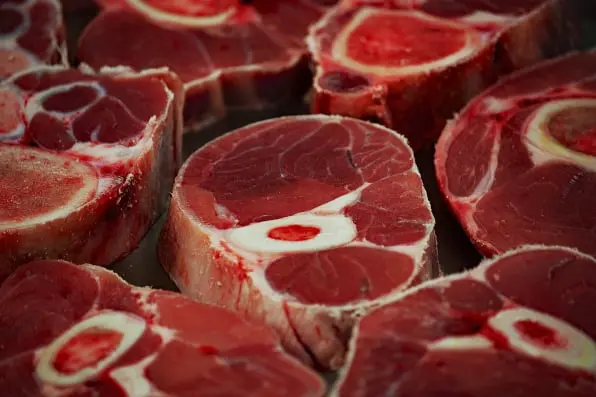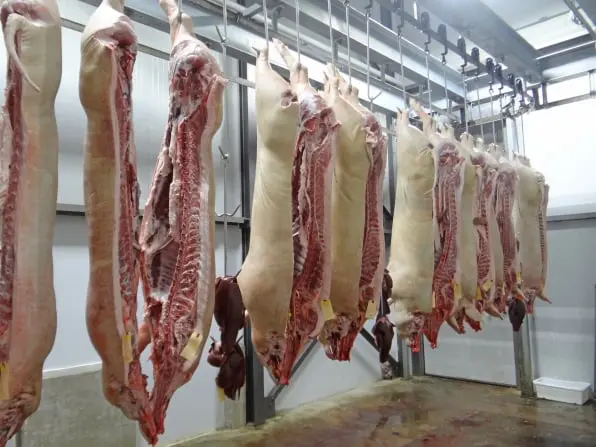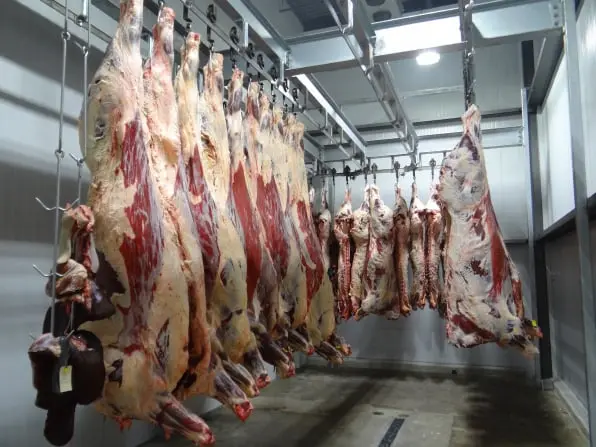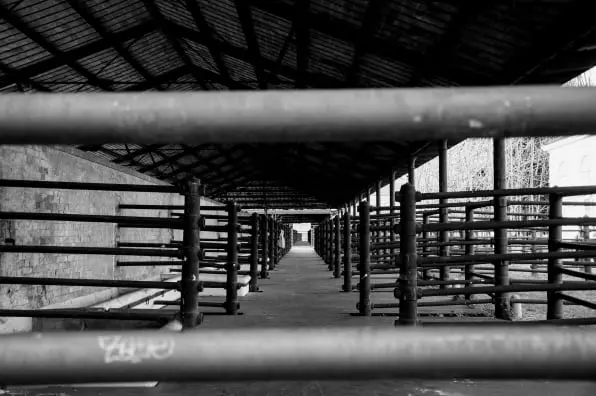Slaughterhouse software
Slaughterhouse software solution from livestock delivery, slaughter & harvesting, drying & grading, fabrication and packing, customer collection of processed animal products, automatic issuance of invoices for animal processing, fabrication, packing & storage/delivery.

Slaughterhouse software for production & shipping
View Traceability App Specifications.
Slaughterhouse software from Farmsoft manages livestock inventory for beef, bison, sheep: Full slaughterhouse management solution from livestock delivery to customer collection of processed animal products.
A slaughterhouse, also called abattoir (/ˈæbətwɑːr/ (listen)), is a facility where animals are slaughtered to provide food for humans. Slaughterhouses supply meat, which then becomes the responsibility of a packaging facility.
Slaughterhouses that produce meat that is not intended for human consumption are sometimes referred to as knacker's yards or knackeries. This is where animals are slaughtered that are not fit for human consumption or that can no longer work on a farm, such as retired work horses.
Slaughtering animals on a large scale poses significant issues in terms of logistics, animal welfare, and the environment, and the process must meet public health requirements. Due to public aversion in different cultures, determining where to build slaughterhouses is also a matter of some consideration.
Frequently, animal rights groups raise concerns about the methods of transport to and from slaughterhouses, preparation prior to slaughter, animal herding, and the killing itself.[1]
Slaughterhouse software from Farmsoft manages livestock inventory for beef, bison, sheep: Full slaughterhouse management solution from livestock delivery to customer collection of processed animal products.

Slaughterhouse software factory hygiene checklist
These slaughterhouses were regulated by law to ensure good standards of hygiene, the prevention of the spread of disease and the minimization of needless animal cruelty. The slaughterhouse had to be equipped with a specialized water supply system to effectively clean the operating area of blood and offal. Veterinary scientists, notably George Fleming and John Gamgee, campaigned for stringent levels of inspection to ensure that epizootics such as rinderpest (a devastating outbreak of the disease covered all of Britain in 1865) would not be able to spread. By 1874, three meat inspectors were appointed for the London area, and the Public Health Act 1875 required local authorities to provide central slaughterhouses (they were only given powers to close unsanitary slaughterhouses in 1890).[13] Yet the appointment of slaughterhouse inspectors and the establishment of centralised abattoirs took place much earlier in the British colonies, such as the colonies of New South Wales and Victoria, and in Scotland where 80% of cattle were slaughtered in public abattoirs by 1930.[14] In Victoria the Melbourne Abattoirs Act 1850 (NSW) "confined the slaughtering of animals to prescribed public abattoirs, while at the same time prohibiting the killing of sheep, lamb, pigs or goats at any other place within the city limits".[15] Animals were shipped alive to British ports from Ireland, from Europe and from the colonies and slaughtered in large abattoirs at the ports. Conditions were often very poor.[16]
Slaughterhouse software from Farmsoft manages livestock inventory for beef, bison, sheep: Full slaughterhouse management solution from livestock delivery to customer collection of processed animal products.
Attempts were also made throughout the British Empire to reform the practice of slaughter itself, as the methods used came under increasing criticism for causing undue pain to the animals. The eminent physician, Benjamin Ward Richardson, spent many years in developing more humane methods of slaughter. He brought into use no fewer than fourteen possible anesthetics for use in the slaughterhouse and even experimented with the use of electric current at the Royal Polytechnic Institution.[17] As early as 1853, he designed a lethal chamber that would gas animals to death relatively painlessly, and he founded the Model Abattoir Society in 1882 to investigate and campaign for humane methods of slaughter.

Slaughterhouse software for Traceability
The development of slaughterhouses was linked with industrial expansion of by-products. By 1932 the British by-product industry was worth about £97 million a year, employing 310,000 people. The Aberdeen slaughterhouse sent hooves to Lancashire to make glue, intestines to Glasgow for sausages and hides to the Midland tanneries. In January 1940 the British government took over the 16,000 slaughterhouses and by 1942 there were only 779.[19]
Inside the Slaughterhouse
Most Americans never see the inside of the factories where beef cattle are slaughtered and processed. FRONTLINE asked Bill Haw, CEO of one of the country's biggest cattle feedlot operations, and journalists Michael Pollan and Eric Schlosser to describe what it's like -- for the cows and the people who butcher them -- inside the slaughterhouse. Here are excerpts from their interviews.
My cow has a date with the knocker, or the stunner, in June. One day in June, he will be judged sufficiently fat, because they really do get obese. And they move around at the end with that kind of the lugubrious awkwardness of the truly obese. And the owner of the feedlot, the manager, will say, "This pen is ready."
Then they will get on another truck and travel 100 miles to Liberal, Kansas, to a National Beef plant there. They will be put in a pen in a parking lot and wait their turn, and go up the ramp, and through a blue door. I was not allowed to go through the blue door. The kill floor is not something that journalists are allowed to see, even if you own the animal, I learned.
But I have reconstructed what happens on the other side of the blue door. What happens is that the animals go in single file. At a certain point, they pass over a bar, their legs on both sides, and the floor slowly drops away, and at that point they're being carried along sort of on that bar, which is a conveyor belt, and they then pass through a station where there's a man on the catwalk above. He's holding an object that looks like a power nailing gun or something. It's a pneumatic device called a stunner.
This essentially injects a metal bolt. It's about the size and length of a thick pencil into its brain, right between the eyes, and that should render the animal brain dead.
At that point, chains will be attached to his rear legs. He will be lifted up by the chains. The chains are attached to an overhead trolley, and then he will be bled. Another person in another station will stick a long knife in and cut his aorta and bleed the animal. And then he will be completely dead.
And from there he goes through a series of stations to clean him and to remove his hide. One of the real problems is that the animals have spent their [lives] lying in their manure, are smeared and caked with the stuff, and they're entering the food plant. And so many steps are taken to make sure that the manure doesn't infect the meat, which can happen very easily.
And this is really just the source of food-safety problems in the industry, in the beef industry, is microbes in the manure getting into the meat. So how do you stop that?
How do [slaughterhouses] contribute to the spreading of pathogens or the increased food safety risks?
... At a slaughterhouse, you have big animals entering at one end, and small cuts of meat leaving at the other end. In between are hundreds of workers, mainly using handheld knives, processing the meat. So during that whole production system, there are many opportunities for the meat to be contaminated. What we're really talking about is fecal contamination of the meat from the stomach contents or the hide of the animal.

Slaughterhouse software for Supplier Traceability
The slaughterhouses that the United States have are pretty unique in terms of the speed of production. We have slaughterhouses that will process 300, 400 cattle an hour, which is as much as twice as many as anywhere else in the world. And it's that speed of production that can lead to food-safety problems. When workers are working very quickly, they may make mistakes. It's during the evisceration of the animal, or the removal of the hide, that manure can get on the meat. And when manure gets on some meat, and then that meat is ground up with lots of other meat, the whole lot of it can be contaminated. ... Slaughterhouse software from Farmsoft manages livestock inventory for beef, bison, sheep: Full slaughterhouse management solution from livestock delivery to customer collection of processed animal products.
I would imagine that a lot goes into the design of these factory production lines to make them very efficient. ... So you would think that they would be expert at doing their job and therefore contain the pathogens in some way. Is that how it works?
There have been a lot of technological advances in slaughterhouses, and especially food safety technology improvements since the Jack in the Box outbreak, these steam cabinets and various washes and interventions. But one of the problems is the high, high turnover rate among workers at these plants. The industry averages anywhere from 75 percent to 100 percent a year, which means you have a constant flow of workers in and out of these jobs.
Ideally, what you would have would be skilled workers and a stable work force, so that people really know the jobs they're doing and can do them properly. ... That's not what we have right now ... especially [with] some of the most important jobs in terms of the evisceration and the tying off of the intestines. These are really unpleasant jobs, and if the workers are not skilled at doing them, they can make mistakes that contaminate the meat. ...
I've always had the sense that a slaughterhouse is a terrible job. It's a difficult job. That people have been doing too much in too short a time. Is it really any different now?
It's very different now. Work in a slaughterhouse has changed enormously in the last 25 years. It's always been a difficult job. It's always been a dangerous job. But up until recently, this was a job that had good pay, had good benefits, and you had a very stable work force. In the early 1970s, meatpacking had one of the lowest turnover rates of any industrial job in America. It was like being an autoworker.
Then they cut wages, they cut benefits, broke unions. And now it has one of the highest turnover rates of any industrial job. So you have a constant churning of the workers. And just like airport security -- where the airport security workers had a high turnover rate and [were] being treated badly and paid poorly, and that has an impact on airport safety -- I think the same is true with food safety.
The people who are working in these plants should be well trained and well paid, and it should be a stable work force. I think that would have a big impact on the safety of the food we eat. ... Slaughterhouse software from Farmsoft manages livestock inventory for beef, bison, sheep: Full slaughterhouse management solution from livestock delivery to customer collection of processed animal products.